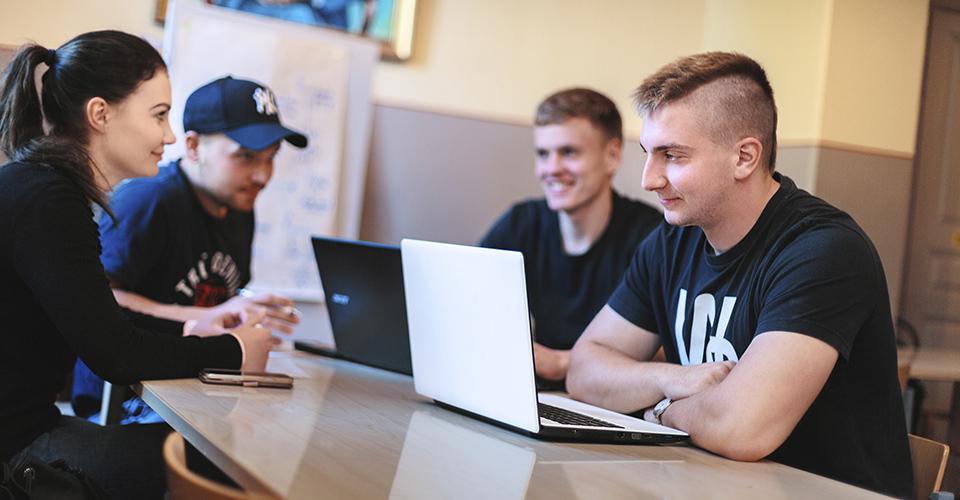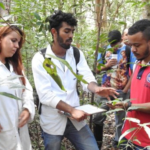
Outi Vahtila
What does the team learning model require from the planning of teaching?
The team learning model is built upon a competence-based curriculum, in which the learning goals of each module are based on a real-life phenomenon. An exercise synthesising competences is essential to the model. This exercise can consist of smaller parts. Also the general subjects: maths, languages, information technology and communications, are integrated into the module. In team learning, assessment is one of the most important elements. It must be closely intertwined with the assessment criteria, be continuously present, and enough time should be allowed for it. The evaluation consists of four parts. It includes a self-appraisal, peer evaluation, teacher assessment and a possible work evaluation.
How does teaching in teams change the teachers’ work?
Teaching in teams requires project and networking expertise, as well as an ability to guide practical work in addition to substance and pedagogical competence. In addition, support personnel is needed for different problem situations. The teacher acts as an instructor, thus increasing interaction. The students are progressively independent searchers and appliers of information. And so, the teacher should know how to plan the learning and instruction processes and guide the students to learning. Caring guidance ensures the progress of learning. One teacher aptly said that the teacher is “a tutor at heart”. This means that the teachers are able to build a functional interaction with the students. The teachers have noticed that, in team learning, the learning responsibility is passed on as a natural process to the students.
How does team teaching alter the activities?
The difference between a group and a team is often examined. The main distinctions are management and the division of labour. Teams have leaders, but their role is focused on sharing goal-oriented responsibility rather than dividing tasks. In a group, the delegation and division of labour are central, whereas teams tend to function through roles. The team members’ mutual interaction generates increasing competence in different areas. Real cooperation takes places in a team, while in a group, the members’ personal responsibilities are more prominent.
On the Mustiala campus, people have been happy with the reform, and they do not want to return to the old. From the management point of view, it has meant abandoning the traditional planning of work. Matters are agreed upon on a very rough level. Work tasks are defined as objectives, not as assignments or teaching hours. The main responsibility for modules is agreed upon with the teachers, and teachers design the modules in teams. The goal is that each teacher has the main responsibility for only one module at a time.
What does team learning require from the structures?
Moving into team teaching required a substantial transformation in the teaching structures. Previous courses based on a few credits and built on different subjects were abandoned. Instead, modules consisting of 15 credits were introduced. One module takes eight weeks. Focusing on one big issue at a time enables deep learning.
The transformation meant abandoning conventional schedules. In module-based learning, the issues are presented as week themes around which all action is planned. The week programmes consist of short bulletins, contact learning sessions and time allocated for autonomous teamwork. The learning progress is monitored through different types of presentations.
An opportunity to participate in contact learning either on the spot or through remote connection adds flexibility to the studies. If the student does not participate in contact learning, they can complete the assignments independently either in an accelerated pace or alongside work in a multiform manner. In principle, teamwork is preferred, but it is also possible to work individually.
Induction to team learning takes place right at the beginning of studies. The team and project learning theme day creates an understanding of how important teamwork skills are in the working life. At the same time, the deepest essence of learning is contemplated on – how personal engagement and combining theory and practice are the starting point for everything. A small project assignment demonstrates how cooperation is successful and fun even in a very short amount of time.
As part of the theme day, a team test is carried out which gives a personal result. On the basis of the team test and previously acquired professional competence, the students are divided into the most varied teams possible. This is to ensure the best possible configuration for the operation of the teams.
What does team learning require from the learning environment?
The success of the work is subject to the appropriate team learning environment and tools. Personal computers and smart phones are important and facilitate learning, while traditional computing suites are no longer needed. Online lectures and video recordings are now a part of everyday life. The physical facilities should be easily adaptable to different functional exercises.
What kind of experiences do Mustiala teachers and students have of teaching and learning in teams?
Teaching in teams was introduced in 2013, and experiences have accumulated over four years. After a slow start, the participants have been rather satisfied with the operational model. Joint planning and working together are visible in the results as well as in the team spirit. Peer activities help you stay in the group better. Experience has shown that the building of team spirit requires good knowledge of oneself and the others. Good results always require a common goal and enthusiasm. In successful teamwork, the result is always greater than the sum of its parts.
What should be considered if the transition to team learning will be made?
The decision about moving to team learning is a strategic one. The entire organisation must commit to the decision and the change should be managed. The matters to be reconsidered include, for instance, agreements, management, roles, decision-making, job design methods, communication, evaluation, feedback, implementation of equality and justice, tools and environments. A workbook has been designed to facilitate the planning.
This article was originally published as Kokemuksia tiimioppimisesta in Finnish in March 2017.
Author
Outi Vahtila, M.Sc. (Agr.), Development Manager, Häme University of Applied Sciences





